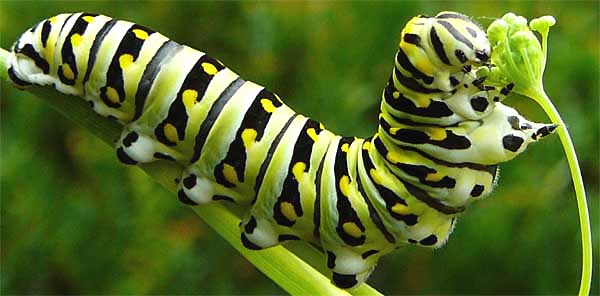
photo by Ruth McMurtry of Kentucky
Remember that in complete metamorphosis this happens:
In that flowchart, caterpillars are larvae. They're the immature stage of certain kinds of insects, especially butterflies and moths. As the Black Swallowtail Butterfly caterpillar above shows, a caterpillar's main job is to eat and eat.
After eating, the caterpillar's big job is just staying alive. The Black Swallowtail Butterfly caterpillar shown above is soft and juicy, with no spines, sharp teeth or stinger. It seems an easy meal for a bird or lizard, so what's keeping this caterpillar from being eaten? Well, sometimes they do get eaten, but mostly they don't, because this caterpillar species, scientists assure us, tastes bad. And its bright colors and striking patterns warn potential predators not to eat them!
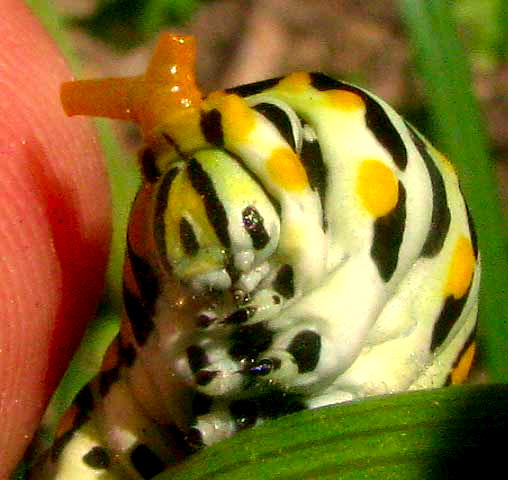
Black Swallowtail caterpillars also have a special weapon to deploy against predatores, shown at the right. It's the yellow, Y-shaped thing atop the caterpillar's head. That's an osmeterium. Some caterpillars have them but most don't. Usually the osmeterium is hidden, but if the caterpillar feels threatened, it shoots out and emits a strong odor that disgusts most predators, making them back away. Anything stinking like that must be dangerous!
Most caterpillar defenses against being eaten aren't as fancy as that, though. For example, below you see a Hawaiian Beet Webworm hiding from predators by simply being hard to see against the leaf's green background.
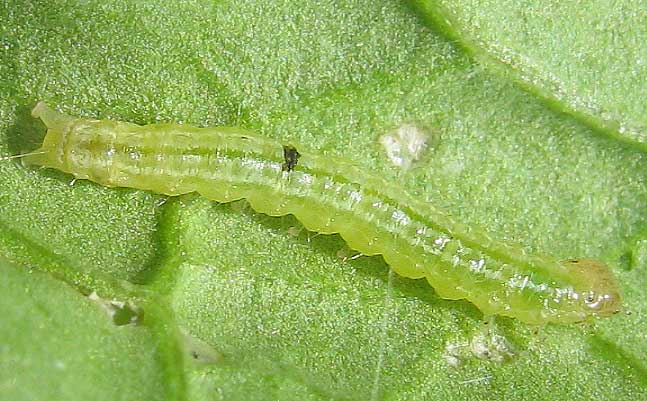
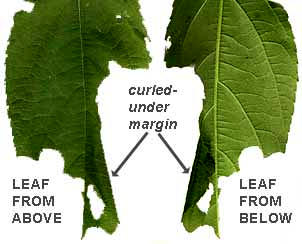
Some caterpillars feed under cover of night, then hide from their predators during the day, maybe beneath loose flakes of tree bark, 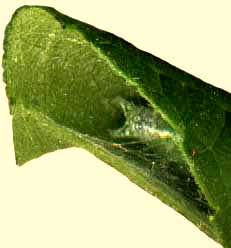 or inside curled-over leaf margins, as shown at the right. There a caterpillar has formed a shelter by wrapping the margin of a leaf over itself, securing the wrapped-over part in place with silk threads. At the left you can see the forked end of a green caterpillar peeping from inside its curled-leaf shelter.
or inside curled-over leaf margins, as shown at the right. There a caterpillar has formed a shelter by wrapping the margin of a leaf over itself, securing the wrapped-over part in place with silk threads. At the left you can see the forked end of a green caterpillar peeping from inside its curled-leaf shelter.
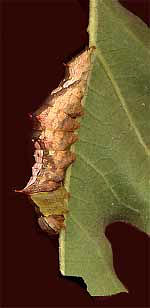
From a distance, the dangling, worm-eaten Black Oak leaf shown at the right looks like just another tattered leaf with a brown blotch of dead tissue on it. However, that dead tissue is a caterpillar that with its irregular form and random-seeming patterning is camouflaged as a brown blotch. It eats at night, but during the day just perches there, looking blotchy.
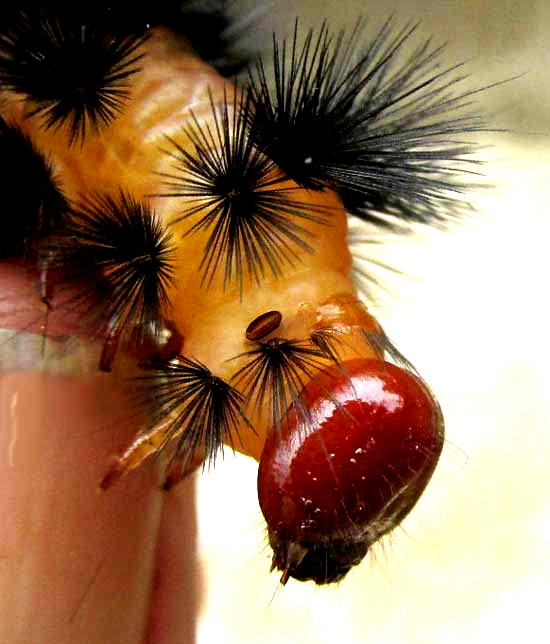
Many caterpillars are too spiny to easily eat, as is the Giant Woolly Bear Caterpillar at the left. Often such spines not only are stiff and sharp, but also they bear glands producing chemicals that can burn a predator's mouth.
On some caterpillars the hairs don't need to be stiff, sharp or stinging to keep predators away. Just the long, soft hairs on the Fall Webworm shown below might make a bird gag. Add the pellets of caterpillar poop stuck to the hairs, and the fact that the caterpillar is just one of many inside a "tent" of white, cobwebby silk, and most predators decide they just don't need to bother with such a mess for a meal.
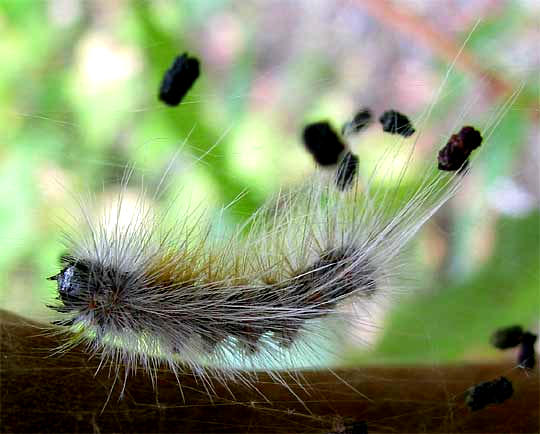
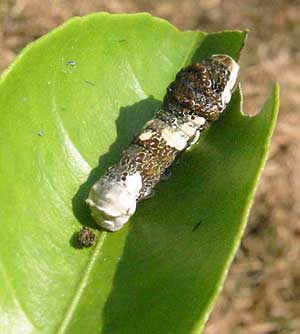
Speaking of poop, what does the caterpillar at the right look like? Doesn't it look like bird poop? That is a truly fancy manner of hiding one's juicy edibility by fooling predators.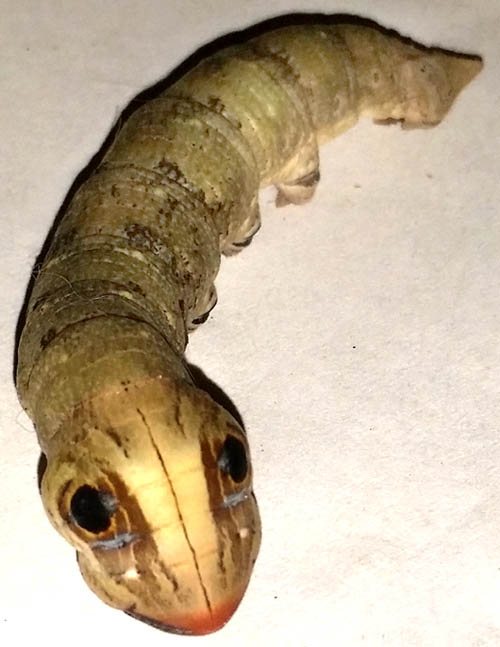 An even more mind-blowing manner of convincing predators to keep their distance is shown in the picture at the left, snapped by tourist Heather Holm during a visit to Yucatan, Mexico. Surely any hungry bird would be be scared to peck at what looks like a big-eyed snake wearing lipstick, staring right at them.
An even more mind-blowing manner of convincing predators to keep their distance is shown in the picture at the left, snapped by tourist Heather Holm during a visit to Yucatan, Mexico. Surely any hungry bird would be be scared to peck at what looks like a big-eyed snake wearing lipstick, staring right at them.
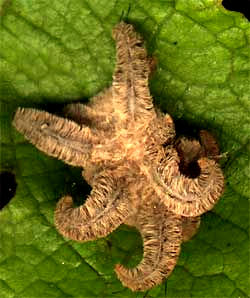 And then there are caterpillars like that at the right, which is the Monkey Slug (Hag Moth Larva), Phobetron pithecium, of the family Limacodidae, photographed in southwestern Mississippi. It's about the size of a man's thumbnail. The curly "arms" are actually just lobes of hairy flesh atop the caterpillar. If you turn the critter over you see normal caterpillar legs and head.
And then there are caterpillars like that at the right, which is the Monkey Slug (Hag Moth Larva), Phobetron pithecium, of the family Limacodidae, photographed in southwestern Mississippi. It's about the size of a man's thumbnail. The curly "arms" are actually just lobes of hairy flesh atop the caterpillar. If you turn the critter over you see normal caterpillar legs and head.
Why would a caterpillar look so strange? Some say that it mimics cast skins of tarantulas, which might unnerve certain predators, but in southwestern Mississippi cast tarantula skins are rare, especially sticking to tree leaves, which is where Monkey Slugs usually turn up in that area. Maybe Monkey Slugs just look so weird that potential predators don't know how to react. Who knows? By the way, those hairs on the "arms" are capable of stinging, so this caterpillar is very well defended, indeed.
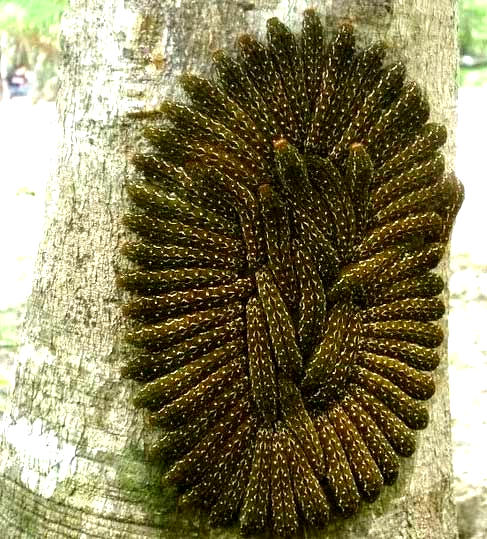
And then some caterpillar species do something like what's shown at the left, massed on a tree at the Mexican ruins of Chichén Itzá, where tourist Vicki Ciau of the Yucatan snapped the picture. They're caterpillars of the Ruby-spotted Swallowtail, Heraclides anchisiades idaeus, and maybe like the Monkey Slug their bizarre appearance simply discombobulates a predator's thinking process or otherwise makes them too nervous to eat. Either way, the caterpillar's get away.
Therefore, when you find a caterpillar, it's always fun to figure out how that caterpillar defends itself from predators. Sometimes, as with those bearing stinging hairs, it's painfully obvious, but other times you may need to do some research.
To find out the caterpillar's defense mechanism, you'd need to identify the caterpillar species, then look it up to see what the experts say. For example, using an Internet search engine and typing in the keywords "Hyphantria cunea caterpillar host," quickly it's learned that that species, the Fall Webworm, eats many kinds of leaves, but especially on hickory, pecan, walnut, elm, alder, willow, mulberry, oak, sweetgum, and poplar trees.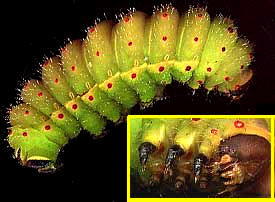
Sometimes it's remembered that insects have six legs, but caterpillars seem to have many more than six. The situation is shown at the right, showing a Luna Moth, Actias luna, found on a Pecan tree in southern Mississippi. The picture's yellow-framed inset shows a close-up of the front of the caterpillar, from below. In the inset, the large, brown thing is the head. To the head's left are six black jointed legs. However, in the larger picture, notice that midway the body there appear to be eight more legs.
Those fleshy, stubby, mid-body appendages are very different from the slender, stiffened, arthropod-jointed legs referred to when it's said that insects have six legs. They are called prolegs, and they function very well as legs but they're not "real" legs. Furthermore, notice that at the caterpillar's rear end, at the left in the picture, there's a special pair of prolegs, called anal prolegs. They make pretty good legs, too, but also they are not to be counted as "real legs."
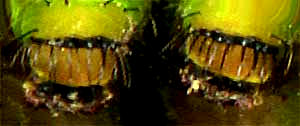
Those pudgy, mid-body prolegs are worth looking at closely. At the left you see a much-magnified close-up of two of the above caterpillar's prolegs. The items looking like black combs are minute, hook-like affairs called hooklets or crotchets. If you ever pull a caterpillar from your clothing you'll notice that as the hooklet-bearing prolegs come unattached, it feels like removing something stuck there with Velcro. In fact, proleg hooklets behave very much like Velcro!
So, that gets you started thinking about caterpillars. Remember that if you find one and want to know more about it, you need to identify it, then look it up. We have a special Insect Identification Page. Also, Bea Laporte's Some Caterpillars Found in Ontario may be helpful.
You might enjoy looking through Jim's field notes on caterpillars he's met in various places.
